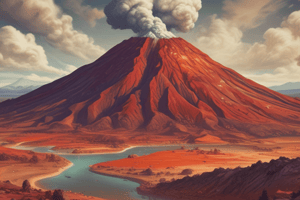Podcast
Questions and Answers
What is the highest temperature that lava from a volcano can reach?
What is the highest temperature that lava from a volcano can reach?
- 1,250°C (correct)
- 800°C
- 1,000°C
- 1,500°C
Where is the world's largest active volcano located?
Where is the world's largest active volcano located?
- Tonga
- Hawaii (correct)
- Japan
- Iceland
What is the name of the volcano that destroyed and buried the town of Pompeii?
What is the name of the volcano that destroyed and buried the town of Pompeii?
- Mount Vesuvius (correct)
- Mount St Helens
- Mount Kilimanjaro
- Mauna Loa
How many volcanoes on Earth are considered active?
How many volcanoes on Earth are considered active?
What is special about the volcano Loihi?
What is special about the volcano Loihi?
What is the 'Ring of Fire'?
What is the 'Ring of Fire'?
What is special about Kilauea?
What is special about Kilauea?
What is Mount St Helens known for?
What is Mount St Helens known for?
What is the name of the mountain in Tanzania that is a dormant volcano?
What is the name of the mountain in Tanzania that is a dormant volcano?
What is one benefit of volcanic eruptions?
What is one benefit of volcanic eruptions?
Flashcards are hidden until you start studying
Study Notes
Volcano Formation
- Volcanoes form at constructive plate boundaries where tectonic plates move apart, creating a gap in the Earth's crust for magma to escape.
- At destructive plate margins, the heavier plate is pushed down into the Earth's mantle, melting into magma that rises to the surface.
Types of Volcanoes
- Composite volcanoes have steep sides due to thick, sticky lava that doesn't flow far before solidifying, leading to violent and explosive eruptions.
- Shield volcanoes have gentle, sloping sides due to thin, runny lava that flows far before solidifying, resulting in non-violent eruptions.
- Cinder cones are formed by small fragments of magma cooling quickly and falling as cinders, forming a crater around the volcano's summit.
Volcano Characteristics
- A volcano typically looks like a mountain or hill with a conical shape, featuring a main vent and often secondary vents.
- Lava from a volcano can reach temperatures of up to 1,250°C.
Volcano States
- Volcanoes are categorized according to their level of activity, with active, dormant, and extinct volcanoes.
- The 'Ring of Fire' contains 75% of the world's volcanoes, with 452 volcanoes stretching from South America to Japan and New Zealand.
Notable Volcanoes
- Mauna Loa in Hawaii is the world's largest active volcano, standing at 4,169m tall, and last erupted in 1984.
- Mount Vesuvius in Italy destroyed the town of Pompeii in A.D. 79.
- Mount St Helens in North America erupted in 1980 and 2008, with scientists predicting a future eruption.
- Mount Kilimanjaro in Africa is a dormant volcano.
Studying That Suits You
Use AI to generate personalized quizzes and flashcards to suit your learning preferences.




